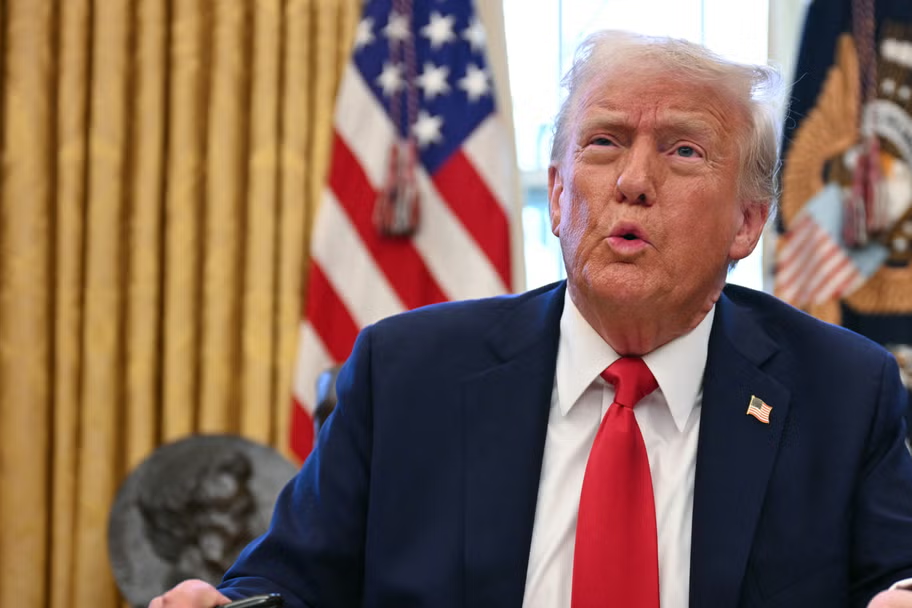Donald Trump on Monday signed an executive order that did not for once focus on freezing government budgets or implementing the tenets of Project 2025.
The order directed the Treasury and the Commerce Department to develop a plan for establishing a sovereign wealth fund, which Trump hopes will one day rival that of Saudi Arabia.
“Eventually we’ll catch [up to] it,” he vowed.
The president also suggested such a fund could buy a 50 percent stake in TikTok from its Chinese parent company ByteDance, allowing the video app to continue operating legally in the U.S.
But what is a sovereign wealth fund, and how do they work? And how exactly could it resolve the impasse between TikTok and the U.S. government?
Sovereign wealth funds, also known as sovereign investment funds, are an old idea, although the term itself was only coined this millennium.
The first examples were established by American states in the 19th century, with Texas leading the way. To this day, the Lone Star State’s education system is partly supported by revenue from the Permanent School Fund and Permanent University Fund, founded in 1854 and 1876, respectively.
But it was the oil-rich Middle Eastern nation of Kuwait that took the idea national in 1953, when it created a fund to manage the proceeds of its drilling industry.
The basic idea of an SWF is simple. Much like any other investment fund, it’s a financial institution that invests money into various assets — such as companies, bonds, or real estate — with the hope of increasing its value.
But unlike other investment funds, these are run by sovereign states on behalf of their citizens. The money they invest is ultimately the property of the nation, and, therefore, so are the proceeds.
The aim is to give the entire country a long-term nest egg, carefully tended in the way the wealthy use fund managers to grow their fortunes. If all goes well, the overall pot gets bigger every year and can provide a cash flow for the country’s public services.
SWFs were often originally based on the proceeds from natural resources such as oil or gas. That’s why they’re often associated with Middle Eastern nations like Kuwait, Saudi Arabia, and Qatar. That was also the origin of Norway’s SWF, which is the biggest in the world with an overall balance of more than $1.7 trillion.
There are already more than 20 states in America – including Alaska, New Mexico, and Texas – that run some kind of sovereign wealth fund, according to the Washington, D.C.-based Center for Global Development.
They sure seem to. Today, according to the tracking firm Global SWF, there are more than 196 SWFs across the world managing a combined fortune of over $13 trillion.
To put that amount into perspective, the money would cover the entire government budget of a smaller country such as Norway for many decades.
It’s also more than the entire amount of money invested in hedge funds and private equity firms across the world, according to the economist Luciano Arvin.
The growth rate of the funds vary, but over the past decade they have tended to average out globally at a respectable 5 to 6 percent annual rate, sometimes as high as 17 percent.
Certainly their investments don’t always go well. In May 2017, back when global interest rates were low and borrowing money was still relatively cheap, a Japanese investment giant called SoftBank announced a massive $100 billion investment fund with the sovereign wealth fund of Saudi Arabia.
For years, the fund poured money into ambitious tech start-ups across the world, from ByteDance to DoorDash and Uber to the ill-starred WeWork. But after the global rise in interest rates in 2022, the Vision Fund began to bleed money and only recently returned to profitability.
SWFs have been criticized as opaque and potentially biased in how they make investments, giving states extra power to intervene in the global economy for political reasons, for example — or perhaps to even channel public wealth into the hands of the powerfully connected, and possibly corrupt.
Take Malaysia, where at least $4.5 billion allegedly disappeared from the sovereign wealth fund only to find its way into offshore bank accounts belonging to various friends of the prime minister.
The TikTok ban passed by Congress last year requires that ByteDance sell off the app’s American version to an American company or else be forbidden to operate in the U.S.
Finding such a buyer, however, has been difficult. ByteDance has shown little interest in a sale, and China forbids the export of home-grown A.I. technology such as TikTok’s recommendation algorithms.
Still, a U.S. wealth fund could potentially gather together enough money to make ByteDance a solid offer.
According to Bloomberg, Trump’s advisers have discussed using the U.S. International Development Finance Corporation – which provides loans and insurance to private sector projects in developing countries – to partner with big investors and pivot the country’s foreign aid program towards a for-profit philosophy.
Trump also reportedly said in a campaign speech in September that his administration could put money from tariffs into a sovereign wealth fund that could invest in projects important to national security.
However, it’s not clear what assets would fund the creation of a U.S. SWF in the first place. While the country has substantial oil and mineral reserves, those are already taxed, and the federal government is running a $1.8 trillion deficit.
Like most Trump ideas, it’s big on ambition and short on details. If new Treasury Secretary Scott Bessent is right, Americans will know more within the year.



